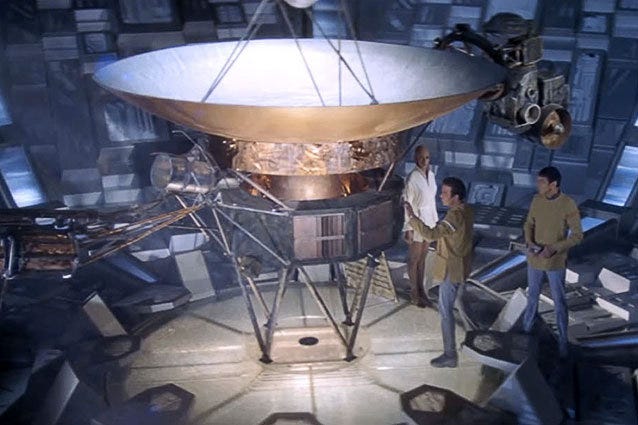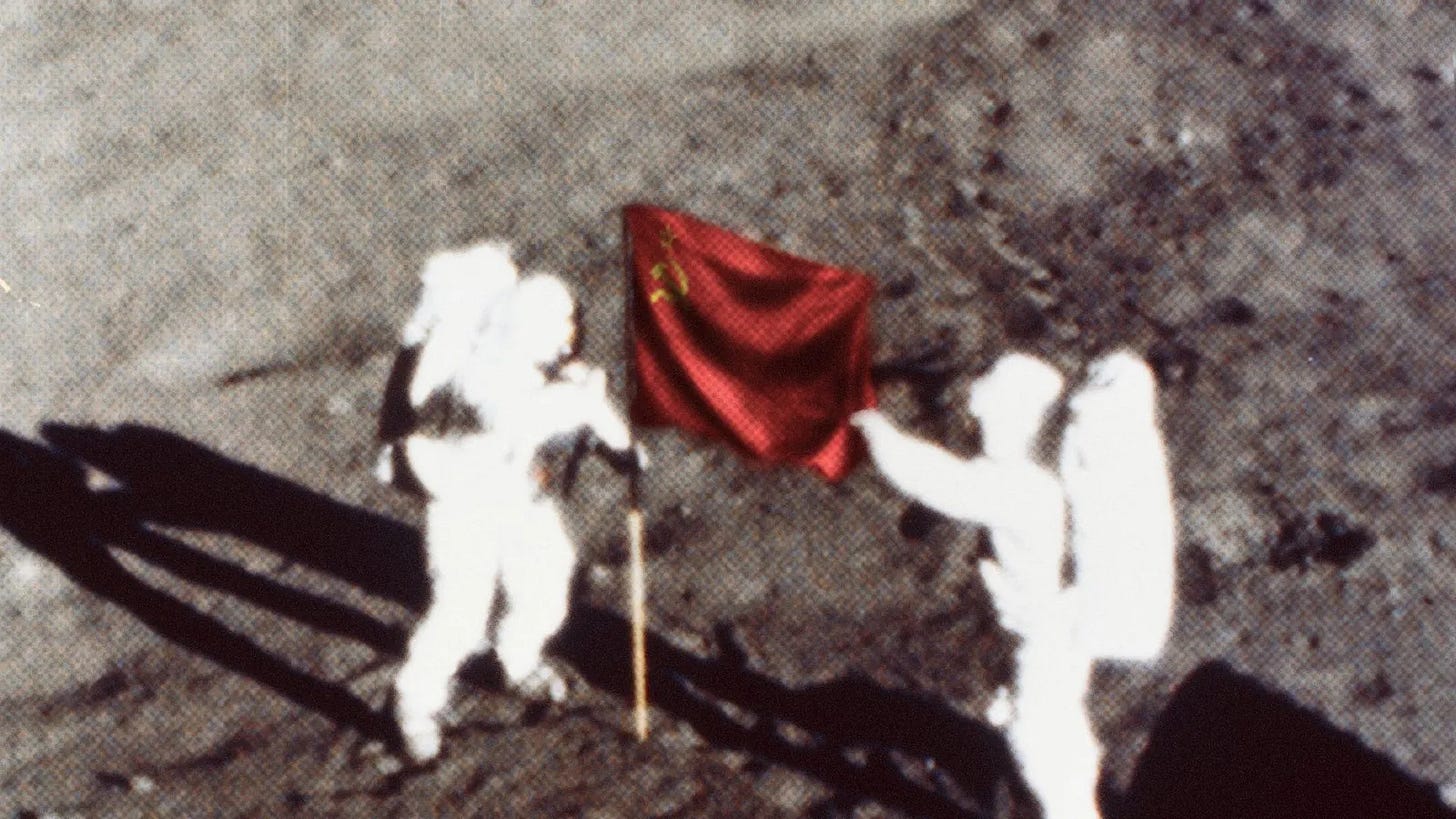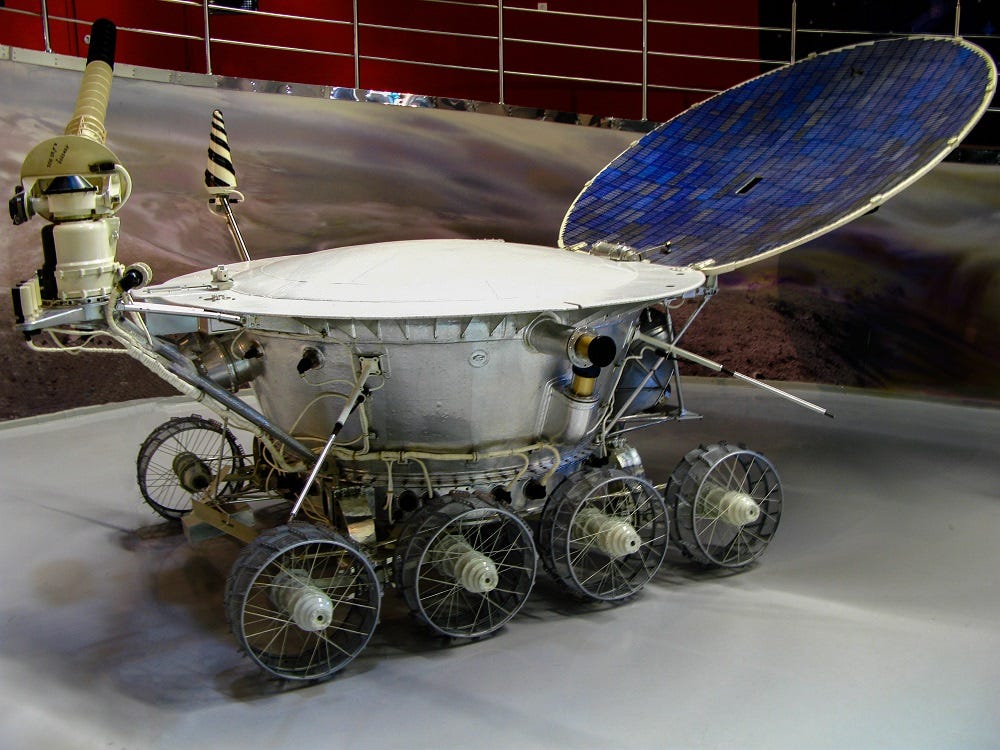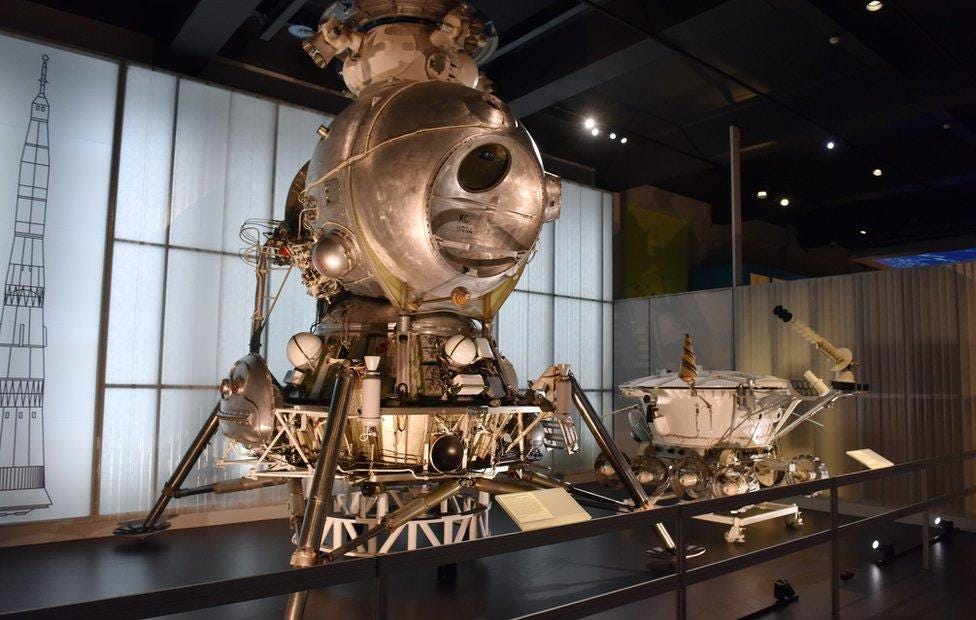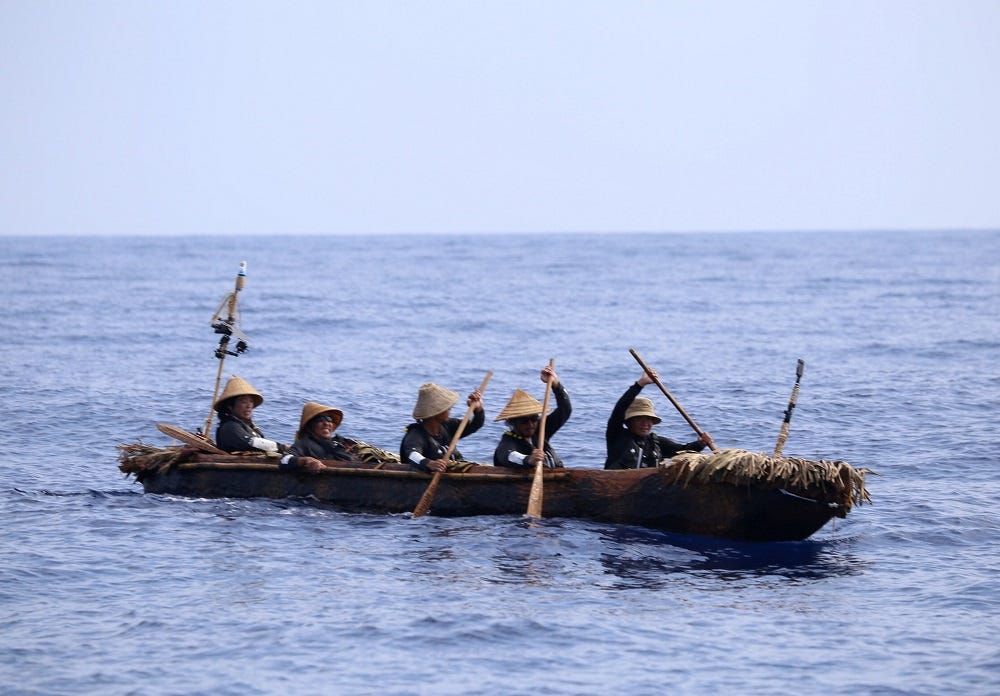The Weird Science Drop #10 🚀 Special tenth anniversary collector's edition
😴 Nightmares can kill you 💊 Mummies put a curse on cancer 🧬 Secret to life found 👴 Plus, how two tortoises beat us to the Moon
“La ora na!* Welcome to the special tenth anniversary edition of TWSD. We’ve made it into double figures and there’s no stopping us now! This week, we take a look at a little slice of alternative history - what if the Soviets had beaten the US to the Moon? As you’ll find out that was never going to happen as their main rocket was a death-trap about as reliable as the 6.45 out of Paddington, but the rest of the kit was ready to go and pretty cool. Read on and don’t forget to hit that subscribe button!”
Daniel
* Good morning in Tahitian
A photon checks into a hotel and is asked if he needs any help with his luggage. He says… scroll to the end to find out!
Weird Science News ✍
😴 It’s official. Nightmares can kill you. Researchers from Imperial College London crunched the numbers on almost 200,000 people and found having nightmares on a weekly basis accelerates ageing – and could even triple the risk of an early death. Abidemi Otaiku, who headed up the study, didn’t mince his words when he said:
“People who have more frequent nightmares age faster and die earlier.
The researchers say people who reported having nightmares every week were more than three times as likely to die before they turned 70 than those who slept peacefully.
Otaiku claims the team found nightmare frequency to be an even stronger predictor of premature death than smoking, obesity, poor diet or lack of physical activity. Read more on New Scientist
🧬 One of the secrets to life on Earth has been uncovered by NASA scientists looking to find a link between our planet’s magnetic field and the level of oxygen in the atmosphere. Over the past 540 million years, both have ebbed and slowed, risen and fallen, with the suspicion that a strong magnetic field, which protects the atmosphere from being stripped away by the solar wind, gives the planet breathing space to build up the life-sustaining gas needed to keep us going.
After much mind-bending analysis, researchers have indeed found that the magnetic field and oxygen levels have fluctuated in near lockstep since the Cambrian explosion, a period when complex life first flourished on Earth. As well as shedding light on our own ball of rock, the findings could also help the search for life on other planets. Read more on India Today
🍄 The feared ‘mummy’s curse’ could have an upside. Fungus found in ancient tombs thought to have offed many an archaeologist is now being used in the fight against cancer.
Molecules derived from Aspergillus flavus could potentially disrupt the growth of leukaemia cells, offering a new avenue in the fight against The Big C. It does this by putting the brakes on the uncontrolled cell growth that is the hallmark of the disease
A recent study from the University of Pennsylvania tested these molecules against common cancer cells. Some displayed ‘potent’ effects, even without modification, against leukaemia cells.
This is not the first time fungi have come to our aid, having already given us penicillin, a drug that is thought to have saved 500 million lives. Read more on World Today News
🚀 Space is big. Really, really big. Just as an example, a human-made craft is close to reaching one light day away from Earth almost 50 years after it was launched. Voyager 1 has been speeding away from us all for decades, so much so that it bid farewell to the solar system back in 2012. It’s motoring along at 38,025mph but after all this time it still won’t reach 24 light hours away until the back end of 2026.
So that’s the distance a beam of light would travel in a day - 1.609×1010 miles. That’s quite the distance. Voyager 1 is expected to run out of power for good in the 2030s but its interstellar journey will continue. Carrying one of the famous gold discs holding the best of human knowledge (when the 70s’ version, anyway), the craft will pass within 1.6 light-years of the star AC+79 3888 in about 40,000 years.
Also known as Gliese 445, this star is actually more moving towards us rather than Voyager moving towards it. Currently 17.1 light-years away from us, by the time the probe makes its close approach it will be just 3.5 light-years away. Read more on IFL Science
By the way, did you know the Voyager mission was all down to a lowly NASA intern? One for a future TWSD!
🕸 We’re big fans of spiders here on TWSD. And only a few weeks ago we mentioned scientists were genetically engineering our eight-legged friends just for, from what I can make out, a laugh. And now here comes another discovery - but one that could be a lot more useful.
As a major global warming gas, methane can be a real pain. But scientists have found three species of sea spiders off the US West coast that like nothing more than to munch on methane being leaked from the sea floor.
According to Shana Goffredi, the study’s principal investigator, the discovery is an example of nature looking after the planet. Goffredi said:
“While the deep sea feels really far away, all organisms are interconnected. Even though they’re small, these animals have a big impact in that environment.”
Read more on Interesting Engineering
Flying the red flag - or how a tortoise beat us to the Moon 🌖🐢
The Space Race - East vs West, the USA vs the USSR, goodies vs baddies, money vs workers, Rocky vs Drago. However you want to frame it, the Americans lifted the trophy when Neil Armstrong set foot on the lunar surface. Sure, the Soviets might have racked up many more ‘firsts’ along the way, but best not to think too much about that.
Despite denying it at the time, the USSR was definitely in the race. It had plans, equipment and cosmonauts ready to go. The only issue is the Soviets didn’t have the rocket power to get a man to the Moon. The great mastermind behind all their early success had died (we’ll no doubt feature the great ‘Chief Designer’ in TWSD one day), and his successors weren’t up to scratch.
To say their version of the Saturn V rocket that took Armstrong and co to the Moon was, to put it bluntly, an accident waiting to happen is something of an understatement. Rushed and done on the cheap, the N1 was powered by a madcap cluster of 30 engines. That’s a lot that can go wrong. And they did - spectacularly. Here’s a typical launch…
So, putting aside not having enough oomph to take a man all the way, what did the USSR’s plans look like? They were actually kinda cool in a retro/sliding doors/weird kind of a way.
First off, let’s go for weird and something that actually happened. A year before Apollo 11 made its landing, the Soviets did send up the first terrestrial beings ever to orbit our close companion. Like a low-rent Noah’s Ark, they fired up a pair of tortoises and a bunch of wine flies, mealworms, seeds, plants, algae and bacteria, to see what would happen.
The unnamed tortoises and their companions all made it back to Earth, where they were studied for any effects of being so close to the Moon.
As we got to 1969 the pressure was really starting to tell on the USSR’s moon race programme and, as a final throw of the dice, they tried in vain to change the narrative from ‘US vs Soviet’ to ‘man vs machine’ by launching Luna 15 just three days before Apollo 11. The robotic sample return mission was designed to take some of the gloss off the Americans by getting Moon rocks back to Earth first and at a fraction of the cost. Running late, Luna 15 crashed into the aptly named Sea of Crises at 300mph.
In the years that followed, the USSR did manage to retrieve some rocks. And, to be fair, they did it far cheaper than Apollo. But by that time, people just didn’t pay much notice, and there was no glory to be had.
Now to the cool retro stuff. The robotic rover called Lunokhod-1 (which literally translates to Moonwalker-1). It was originally designed for humans to drive but was sent up sans man in 1970. Operated from Earth in real time (crazy in itself), the 1.5m tall rover spent 11 days travelling around the surface.
Let’s go all Gwyneth Paltrow and slide those doors. If they had made it to the Moon, what would the mission have looked like?
The technique would have been broadly similar to Apollo just that the names and the look would have been different. For starters, the first man on the Moon would have been Alexei Arkhipovich Leonov. The pioneering cosmonaut was the first person to walk in space and was a shoo-in for the job. By all accounts, he was a very nice chap who was interested in art. Not your stereotypical steely-eyed missile man.
He would have landed - standing at the controls and alone - in the LK-3. A much smaller craft than the Eagle, it wouldn’t have spent as long on the lunar surface, while Leonov would be tethered to his craft when taking his historic stroll so it’s not that he could have gone far anyway.
In many ways the Soviets were more cautious than their American competitors. The LK-3 not only had a backup engine, but also an unmanned lander would have been sent in advance so that Leonov had another ride home if he really needed it.
Armstrong and Aldrin had no such luxury. If the Eagle’s engine failed, they were brown bread.
After Leonov lifted off from the Moon, there was one last super cool moment awaiting him. When the LK-3 reconvened with the craft that would take him home, there was no docking between the two, so the intrepid cosmonaut would have had to open the door, step outside and spacewalk between two spaceships, all while orbiting the Moon. Leonov certainly had the right… what was that stuff?
If you really want to know what would have happened if the Soviets had beaten the USA to the Moon, then check out the series For All Mankind. A criminally overlooked, stone-cold sci-fi alternative history classic.
Photo of the Week 📷
Researchers built a dugout canoe using only stone tools and paddled it 140 miles across treacherous seas to show how people migrated 30,000 years ago. Inspired by Norwegian explorer Thor Heyerdahl's 1947 Kon-Tiki expedition, scientists retraced the routes of early modern humans in East Asia using just the technology available at the time.
For your eye holes 👀
Infographic Magic 📊
Ride the wave of age as it is projected to go in the US up to 2060. It’s actually rather hypnotic.
Cool Quote 🗣
"If you torture the data long enough, it will confess to anything."
Ronald Coase, a British economist and author.
Weird Science Factoid 🤯
Hot water freezes faster than cold water. Yep, you read that right. It’s all down to the mysterious ‘Mpemba effect’. The phenomenon is named after schoolboy Erasto Mpemba from Tanzania, who in the 1960s claimed in his science class that ice cream would freeze faster if it was heated first before being put in the freezer.
Weird Science Fries on the Side 🍟 (aka the best of the rest)
🧊 A black iceberg spotted off the coast of Canada has been making the rounds on social media. The unusual shade could be down to a visitor from space
🌍 Scientists have discovered something unexpected moving 2,700km under Earth's surface. It turns out that solid rock is in constant motion at that depth
👽 If aliens came calling - what exactly is the plan? Turns out scientists have been busy for years preparing to take the world’s most important phone call
✨ An Australian moth follows the stars during its yearly migration, using the night sky as a guiding compass. They are the first known invertebrates to find their way across hundreds of miles using the stars
⛏ Ceres is the largest rock in the asteroid belt and awash with water that can be used to keep space-faring humans alive and power rocket ships. A new study has proposed the building of a 30,000km-long space elevator to tap the H2O.
Did you miss this? More from The Weird Science Drop 👀
Retro flying
Put through the grinder
Brain broken
The most-visited links from the last newsletter 👇
Humans Age Faster at 2 Specific Times in Their Life, Study Finds
We Give Off a Light That Is Extinguished in Death, Study Reveals
NASA's Voyager Spacecraft Found A 30,000-50,000 Kelvin ‘Wall’ At The Edge Of Our Solar System
About The Weird Science Drop 🚀
Science is weird, and here’s the proof. The Weird Science Drop goes where other, more-sensible newsletters fear to tread. Every week, we grab our trusty white lab coat, bunch of bubbling test tubes and world-ending robot prototype to go in search for the overlooked, under-the-radar and, above all else, most madcap science news, views and research.
About me 👴
Daniel Smith is an old experienced journalist who has worked for a host of news publishers on both sides of the Atlantic. A long, long time ago, he fancied himself as an astrophysicist but instead turned out to be the worst scientist since the man who mapped out all those canals on Mars that turned out to be scratches on his telescope's lens. Luckily, he is now not working on the Large Hadron Collider inadvertently creating a black hole that would swallow the world by pressing the big red button but is safely behind a desk writing this newsletter, bringing you the fantastical underbelly of nature... The Weird Science Drop.
Have I missed anything? 🚨
Feel free to throw me an email or just fill out this super simple form. I'll read each and every one. Promise.
"No, I'm traveling light!"




